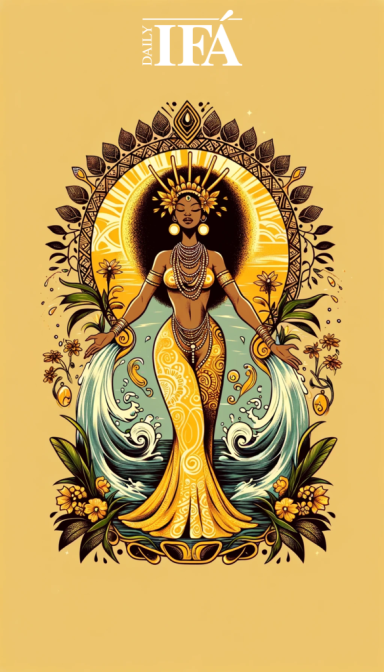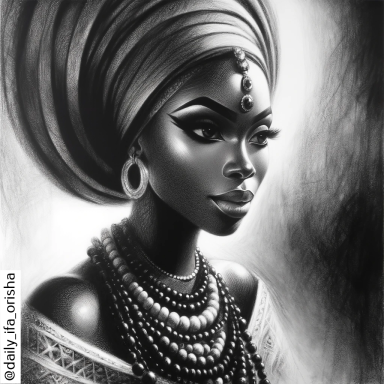
About ORISHÀ OSHUN
Orishá Oshun, also known as Oshun, Ochun, or Oshun, is a prominent figure in the Yoruba religion and its diasporic forms such as Candomblé and Santería. She is revered as a goddess of love, beauty, fertility, wealth, and rivers, embodying the power of water and the essence of sweetness. Oshun's diverse roles and characteristics make her a vital orishá, influencing various aspects of life, from personal relationships and emotional well-being to creativity and material prosperity.
About the ORISHÁ
Roles and
Influence
- Goddess of Love and Sensuality: Oshun is celebrated as the deity of love, sensuality, and attraction, embodying feminine beauty and sexuality.
- Protector of Women and Children: She is a guardian and protector of women and children, offering care, support, and maternal nurturing.
- Goddess of Fertility: Associated with fertility and motherhood, Oshun is invoked for blessings in conception, pregnancy, childbirth, and raising children.
- Bringer of Wealth and Prosperity: She is regarded as the goddess of wealth, abundance, and prosperity, bestowing blessings of success and financial stability.
- Goddess of Beauty and Aesthetics: Oshun inspires creativity, artistry, and appreciation of beauty in all its forms.
- Goddess of Rivers and Freshwater: She has dominion over rivers and freshwater bodies.
- Healer and Purifier: Possesses healing abilities, particularly for ailments of the reproductive system and emotional well-being.
- Patron of Divination: Oshun is associated with divination, particularly using cowrie shells, providing insights and messages from the spirit realm.
- Goddess of Harmony and Diplomacy: Promotes harmony, peace, and diplomacy, mediating conflicts and fostering cooperation.
- Symbol of Sweetness and Joy: She embodies sweetness, joy, and happiness, bringing lightness and pleasure into people's lives.
Characteristics and Symbolism
- Symbols: Fan with a mirror and image of a flying bird, scythe chain with symbolic golden stones.
- Colors: Yellow and gold.
- Natural Places: Waterfalls and calm rivers.
- Flowers: Lily, yellow rose.
- Essences: Lily and rose.
- Stones: Topaz.
- Metal: Gold, bronze, brass, copper.
- Health: Associated with female reproductive organs and the heart.
- Planet: Venus (Moon).
- Weekday: Saturday.
- Element: Freshwater, yellow metal, menstrual blood.
- Chakra: Front umbilical cord.
- Animals/Offerings: Goat, castrated billy goat, chicken, guinea fowl, wild dove.
- Foods and Drinks: Omolocum, cowpea shrimp, yam root, eggs, acaçá, xinxim, white wine.
- Number: 5.
- Commemoration Day: December 8th.
- Syncretism: Associated with various manifestations of the Virgin Mary.
- Manifestations: Various forms and manifestations.
- Incompatibilities: Snail, duck, mandarin, dove, cockroach, pineapple.
Key Manifestations (Aspects)
Oshun manifests in more than fifty forms, including
- Abaê (or Mabê) - Associated Orishas: Yemanjá.
- Abalu - An ancient, quarrelsome, strict, and authoritarian Oshun who loves solitude. Associated Orishas: Iyami-Osorongá, Yemanjá, and Oshalá.
- Abomi - This means "Lady of the Waters." Associated Orishas: Orunmilá.
- Abotô - An ancient Oshun associated with the female nature, especially with the birth of a child. She is also associated with the "birth" of water, as she is the Oshun of springs. Associated Orishás: Nanã and Oyá Igbalé.
- Ajagurá - Young female Oxum and warrior. She carries a sword. Associated Orishás: Yemanjá and Shangô.
- Akidã - An aspect of Oshun associated with Omolu. She is worshiped in very few places. Associated Orishás: Omolu.
- Ayalá (or Íyanlá) - The oldest of the deities in the Oshun pantheon, considered the "great mother." She lives at the bottom of rivers, is a great sorceress, a powerful warrior, the "Lady of the Anvil," and the wife of Alabedé, the oldest Ogum in his group. Associated Orishás: Ogum Alabedé, Iyami-Osorongá, and Orunmilá.
- Guerê (or Lobaguerê) - Worshiped in a few ceremonial houses. Associated Orishás: Eshu and Shangô.
- Iberin - Oshun associated with female sensuality, ornaments, and embellishments. Young, she represents the coquettish side of Oshum. She is the lady of vanity and the desire to be beautiful.
- Ideúa - Rarely worshiped anymore. The name indicates that she is the mother of the "third" brother of the Ibejis. Associated Orishás: Ogum.
- Ijimu - Ancient Oshun associated with magic and fertility. She is the Oshun of riverbeds and has a close connection with the transition from life to death. She is the mother of the riverbed stones, objects sacred to her. Associated Orishás: Omolu, Oshalá, and Iyami-Osorongá.
- Ikolé - She is the bird of Oshun. She is the mother of birds, and myths tell that she flew to the sun in the form of a peacock to ask Olodumare for mercy for the other Orishás and humanity. The sun burned her feathers and transformed her into the vulture, a bird consecrated to her. Associated Orishás: Odé Inlé and Yemanjá Maleleô.
- Ipetu - An ancient Oshun associated with the rivers of the forests and particularly with their springs. Associated Orishás: Ossaim and Oyá Igbalé.
- Ipondá (or Yeyê Ipondá) - Young, warrior-like Oshun associated with the riverbanks in the forests. She is the mythical mother of Logun-Edé and the wife of Odé Ibualamo. She carries a sword. Associated Orishás: Odé Ibualamo, Logun-Edé, Oyá Igbalé, Egun.
- Karé (or Yeyê Karê) - She is also very warlike, but her weapons are the arrow (Ofá) and bow. Associated Orishas: Odé Karê, Yemanjá, and Oshalá.
- Mapô - One of the oldest Oshun responsible for the arrival of humans into the world through normal childbirth, as her domain encompasses the abdomen, internal reproductive organs, pregnancy, fertility, the birth of children, and the female genitalia. She carries the ancestral energy. Associated Orishás: Oshun Abotô.
- Merin-Merin - The Oshun Merin-Merin is female and elegant, the sister of Yewa.
- Mouwô - Oshun associated with the meeting of freshwater and saltwater. She wears light colors and uses Abebê and Alfanje. Associated Orishás: Olokun and Yemanjá.
- Okê, Yeyé Oké - She is a skilled huntress, which is why it is said that she transforms into a man because she perfectly performs a typically male activity. Associated Orishas: Odé, Ewá, and Oyá.
- Olokô, Yeyé Olóko - She is the Oxum who lives in the water wells deep within the forests.
- Opará - She is a companion of Ogum and gets along very well with Oshaguian, the warrior from the Funfun-Orixá group. Associated Orishás: Ogum, Oyá, and Oshaguiã.
Sign-Up for free to your Weekly Newsletter.
Illustrations of the Orishá
Wir benötigen Ihre Zustimmung zum Laden der Übersetzungen
Wir nutzen einen Drittanbieter-Service, um den Inhalt der Website zu übersetzen, der möglicherweise Daten über Ihre Aktivitäten sammelt. Bitte prüfen Sie die Details und akzeptieren Sie den Dienst, um die Übersetzungen zu sehen.




